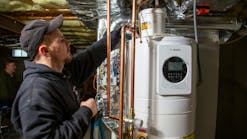The record-breaking, sweltering heat wave that the Southern United States experienced this summer season may have some home-owners rethinking their cooling options. They may be looking for more zoning control or to cool a part of the home that their central air conditioning unit doesn't reach, like an attic that's been converted into an office space or bedroom. Or perhaps they don't have a central air conditioner at all because they live in a home that was built before it became a standard option. In this era of energy efficient yet affordable options, homeowners may want to consider getting a ductless or mini-split system for their homes.
It's an ideal solution for those looking to cool or heat an addition to their home or a home without pre-existing ductwork, which should serve as a reminder to wholesalers when they make suggestions to their dealers. HVACR Distribution Business magazine interviewed three ductless manufacturers to find out the latest equipment and trends in whole house ductless systems.
Latest Equipment
“Our whole house solution revolves around our flex-multi system,” says Don Wojcik, national distribution manager for LG Residential. “You can have up to four zones on a system, which gives instant zoning, excellent dehumidification and a very quiet system that reduces noise pollution.” Wojcik explains that there is minimal invasiveness with installation, and the system has nominal maintenance.
Marc Zipfel, director of product marketing at Mitsubishi Electric Cooling & Heating, says that Mitsubishi offers a zoned-house solution that can connect up to eight zones and is popular for renovations. “It works across a number of applications, like retrofit or renovation, and also conversion of an unused space like an attic or a room in a house with ‘empty nesters.’ If they have a kid go off to college, why keep heating and cooling a room that's not occupied? They can use this system to adapt to that space and turn it off when the room is not in use. They save money and gain additional control through using a zoned-house system.”
Daikin AC offers a new generation two-port, three-port and four-port multisplit system that, according to Marc Bellanger, residential product manager for Daikin AC, can serve up to four rooms and has more than 200 possible combinations. “Our choices include: wall mount units, all slim duct units or a combination of both. With energy efficiency up to SEER 19.5, these systems will enhance the comfort of any home and be easier on electric bills,” Bellanger says.
Why Choose Ductless?
“A homeowner should go for a nonducted solution wherever the house has limited space for ductwork. With this type of application, only a small set of cooling copper pipes would be running through the house,” Bellanger says.
“With the resurgence of purchasing and renovation of an older home, many homes don't have existing ductwork,” Zipfel says. “Rather than putting holes in walls and trying to run ducting or tearing up floors to run ducting and ventilation from a central air package, this is a really great solution because it can address individual room needs, and it's a cost savings because you don't have the labor costs associated with ripping things out and reinstallation.”
Page 2 of 2
“Instant zoning and minimal invasiveness” are key features of choosing a ductless system, Wojcik says. “All that's required is a 2¾-inch opening to get through the drainage line and refrigerant line into the home. It's also very quiet and adds excellent dehumidification to the home.”
Trends
“The main trend is diversification of the product offering to offer solutions that meet more budget scopes, have tiered efficiency and offer a choice to customers in what type of indoor unit is desired,” Bellanger says. “The other trend is enhancement of the overall operational scope of ductless systems to meet the demands of harsher climates, be it very cold ambient temperatures, high humidity areas or even high ambient areas.”
Also trending is that leading manufacturers are moving to inverter technology. “What that gives you is a greater comfort zone inside the home due to their variable loading capacities,” Wojcik says. “With inverter technology, you get greater efficiencies.”
“I've seen great efficiencies as well as greater heating and cooling capacities,” Zipfel adds. “We're seeing much higher BTUs. We're also seeing that you can string together multiple units. We've got a branch box now for residential units that can have up to eight zones. You can connect four or five units using one central outdoor unit.”
Boosting Interest
All manufacturers agree that the best way to boost interest in ductless systems is education.
“One of the single most effective ways to understand this and talk to homeowners is really the education piece,” Zipfel says. “We (Mitsubishi) have training classes that are available where contractor businesses can send installers to learn more about the units and understand the various applications. They will learn to really understand and analyze the homeowners' needs and issues.”
Bellanger believes that contractor and consumer awareness, training distribution networks and energy-efficiency incentives will be an important part in boosting industry interest. He has already seen growth in this market. “We see at least double-digit growth in the market and expect the ductless market to continue to grow for years to come.”
In order for that growth to continue, ductless marketing departments will have to play a bigger role. “More regional and national advertising campaigns will have to start,” Wojcik says. “Visibility at regional home and trade shows, and partnerships with utilities for rebate programs for contractors and homeowners will have to happen. There's more and more of that hitting the industry. Most manufacturers are doing it and realizing the savings.”
Kate Kelly is an associate editor with Contracting Business magazine. Contact her at 216/931-9755 or[email protected].









